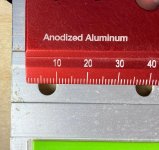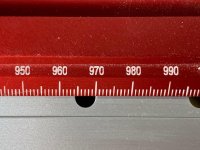I recently purchased the LR32 system and guide rail and used it to make an MFT style top for my outfeed table. It worked OK but I wasn't 100% satisfied with my top (couple of mistakes I made). I also had one made by a local shop with a CNC. When I received the CNC version I checked it against the one I made and after lining up the holes on one side the holes on the opposite side were off by 1/2mm or so.
The CNC shop had specified a tolerance of +/-.005" so I was mildly annoyed. Then I checked the holes with a couple of tape measures and the holes matched what I expected (11 holes 960mm). I went back to the 32mm guide rail and it was out by about .5mm in 1m.
I couldn't find any specs on the guide rail accuracy but I was a little surprised it is this poor. Has anyone else checked the spacing on their guide rail? Curious if I just have a bad rail or if I'm being too anal about this.
The CNC shop had specified a tolerance of +/-.005" so I was mildly annoyed. Then I checked the holes with a couple of tape measures and the holes matched what I expected (11 holes 960mm). I went back to the 32mm guide rail and it was out by about .5mm in 1m.
I couldn't find any specs on the guide rail accuracy but I was a little surprised it is this poor. Has anyone else checked the spacing on their guide rail? Curious if I just have a bad rail or if I'm being too anal about this.






